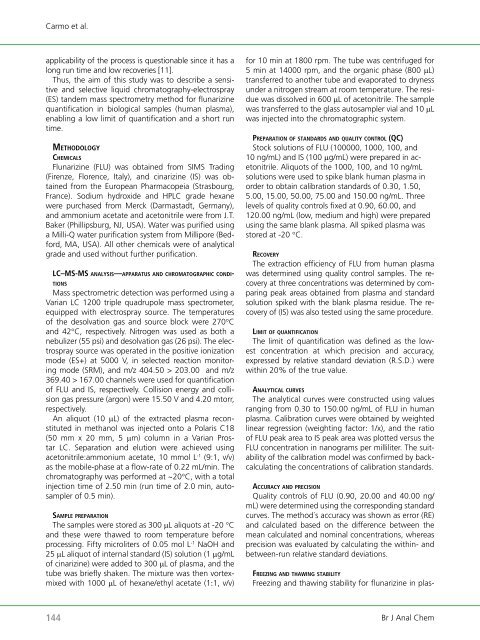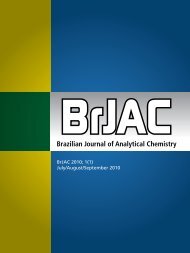Brazilian Journal of Analytical Chemistry - BRJAC - Brazilian Journal ...
Brazilian Journal of Analytical Chemistry - BRJAC - Brazilian Journal ...
Brazilian Journal of Analytical Chemistry - BRJAC - Brazilian Journal ...
You also want an ePaper? Increase the reach of your titles
YUMPU automatically turns print PDFs into web optimized ePapers that Google loves.
Carmo et al.<br />
applicability <strong>of</strong> the process is questionable since it has a<br />
long run time and low recoveries [11].<br />
Thus, the aim <strong>of</strong> this study was to describe a sensitive<br />
and selective liquid chromatography-electrospray<br />
(ES) tandem mass spectrometry method for flunarizine<br />
quantification in biological samples (human plasma),<br />
enabling a low limit <strong>of</strong> quantification and a short run<br />
time.<br />
mE t h o d o l o g y<br />
Ch E m i C a l s<br />
Flunarizine (FLU) was obtained from SIMS Trading<br />
(Firenze, Florence, Italy), and cinarizine (IS) was obtained<br />
from the European Pharmacopeia (Strasbourg,<br />
France). Sodium hydroxide and HPLC grade hexane<br />
were purchased from Merck (Darmastadt, Germany),<br />
and ammonium acetate and acetonitrile were from J.T.<br />
Baker (Phillipsburg, NJ, USA). Water was purified using<br />
a Milli-Q water purification system from Millipore (Bedford,<br />
MA, USA). All other chemicals were <strong>of</strong> analytical<br />
grade and used without further purification.<br />
lC–ms-ms a n a l y s i s—a P P a ra t u s a n d C h ro m a t o g ra P h i C C o n d i-<br />
t i o n s<br />
Mass spectrometric detection was performed using a<br />
Varian LC 1200 triple quadrupole mass spectrometer,<br />
equipped with electrospray source. The temperatures<br />
<strong>of</strong> the desolvation gas and source block were 270°C<br />
and 42°C, respectively. Nitrogen was used as both a<br />
nebulizer (55 psi) and desolvation gas (26 psi). The electrospray<br />
source was operated in the positive ionization<br />
mode (ES+) at 5000 V, in selected reaction monitoring<br />
mode (SRM), and m/z 404.50 > 203.00 and m/z<br />
369.40 > 167.00 channels were used for quantification<br />
<strong>of</strong> FLU and IS, respectively. Collision energy and collision<br />
gas pressure (argon) were 15.50 V and 4.20 mtorr,<br />
respectively.<br />
An aliquot (10 µL) <strong>of</strong> the extracted plasma reconstituted<br />
in methanol was injected onto a Polaris C18<br />
(50 mm x 20 mm, 5 µm) column in a Varian Prostar<br />
LC. Separation and elution were achieved using<br />
acetonitrile:ammonium acetate, 10 mmol L -1 (9:1, v/v)<br />
as the mobile-phase at a flow-rate <strong>of</strong> 0.22 mL/min. The<br />
chromatography was performed at ~20°C, with a total<br />
injection time <strong>of</strong> 2.50 min (run time <strong>of</strong> 2.0 min, autosampler<br />
<strong>of</strong> 0.5 min).<br />
sa m P l E P rE P a ra t i o n<br />
The samples were stored as 300 µL aliquots at -20 °C<br />
and these were thawed to room temperature before<br />
processing. Fifty microliters <strong>of</strong> 0.05 mol L -1 NaOH and<br />
25 µL aliquot <strong>of</strong> internal standard (IS) solution (1 µg/mL<br />
<strong>of</strong> cinarizine) were added to 300 µL <strong>of</strong> plasma, and the<br />
tube was briefly shaken. The mixture was then vortexmixed<br />
with 1000 µL <strong>of</strong> hexane/ethyl acetate (1:1, v/v)<br />
for 10 min at 1800 rpm. The tube was centrifuged for<br />
5 min at 14000 rpm, and the organic phase (800 µL)<br />
transferred to another tube and evaporated to dryness<br />
under a nitrogen stream at room temperature. The residue<br />
was dissolved in 600 µL <strong>of</strong> acetonitrile. The sample<br />
was transferred to the glass autosampler vial and 10 µL<br />
was injected into the chromatographic system.<br />
PrE P a ra t i o n o f s t a n d a rd s a n d q u a l i t y C o n t ro l (qC)<br />
Stock solutions <strong>of</strong> FLU (100000, 1000, 100, and<br />
10 ng/mL) and IS (100 µg/mL) were prepared in acetonitrile.<br />
Aliquots <strong>of</strong> the 1000, 100, and 10 ng/mL<br />
solutions were used to spike blank human plasma in<br />
order to obtain calibration standards <strong>of</strong> 0.30, 1.50,<br />
5.00, 15.00, 50.00, 75.00 and 150.00 ng/mL. Three<br />
levels <strong>of</strong> quality controls fixed at 0.90, 60.00, and<br />
120.00 ng/mL (low, medium and high) were prepared<br />
using the same blank plasma. All spiked plasma was<br />
stored at -20 °C.<br />
rECovEry<br />
The extraction efficiency <strong>of</strong> FLU from human plasma<br />
was determined using quality control samples. The recovery<br />
at three concentrations was determined by comparing<br />
peak areas obtained from plasma and standard<br />
solution spiked with the blank plasma residue. The recovery<br />
<strong>of</strong> (IS) was also tested using the same procedure.<br />
limit o f q u a n t i f i C a t i o n<br />
The limit <strong>of</strong> quantification was defined as the lowest<br />
concentration at which precision and accuracy,<br />
expressed by relative standard deviation (R.S.D.) were<br />
within 20% <strong>of</strong> the true value.<br />
an a l y t i C a l CurvEs<br />
The analytical curves were constructed using values<br />
ranging from 0.30 to 150.00 ng/mL <strong>of</strong> FLU in human<br />
plasma. Calibration curves were obtained by weighted<br />
linear regression (weighting factor: 1/x), and the ratio<br />
<strong>of</strong> FLU peak area to IS peak area was plotted versus the<br />
FLU concentration in nanograms per milliliter. The suitability<br />
<strong>of</strong> the calibration model was confirmed by backcalculating<br />
the concentrations <strong>of</strong> calibration standards.<br />
aCCuraCy a n d PrECision<br />
Quality controls <strong>of</strong> FLU (0.90, 20.00 and 40.00 ng/<br />
mL) were determined using the corresponding standard<br />
curves. The method´s accuracy was shown as error (RE)<br />
and calculated based on the difference between the<br />
mean calculated and nominal concentrations, whereas<br />
precision was evaluated by calculating the within- and<br />
between-run relative standard deviations.<br />
frEEzing a n d t h a w i n g staBility<br />
Freezing and thawing stability for flunarizine in plas-<br />
144 Br J Anal Chem



